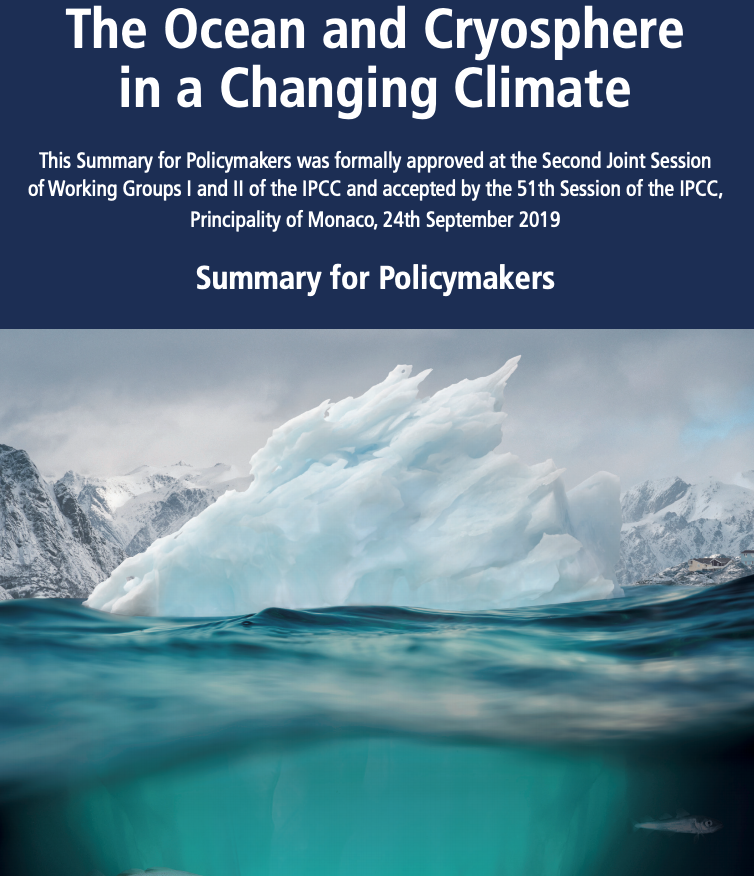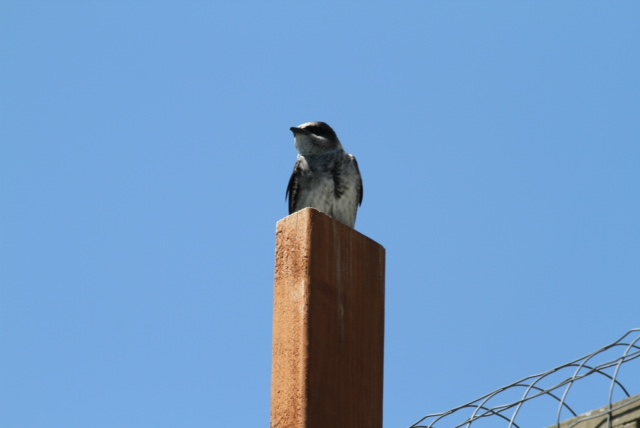This link is now here:
Author Archives: Garry Fletcher
IPCC Report-2019-The Ocean and Cryosphere in a Changing Climate

The complete pdf of the report can be found here:
https://report.ipcc.ch/srocc/pdf/SROCC_FinalDraft_FullReport.pdfIPCC 2019
A5. Since about 1950 many marine species across various groups have undergone shifts in geographical range and
seasonal activities in response to ocean warming, sea ice change and biogeochemical changes, such as oxygen loss, to
their habitats (high confidence). This has resulted in shifts in species composition, abundance and biomass production of
ecosystems, from the equator to the poles. Altered interactions between species have caused cascading impacts on
ecosystem structure and functioning (medium confidence). In some marine ecosystems species are impacted by both the
effects of fishing and climate changes (medium confidence). {3.2.3, 3.2.4, Box 3.4, 5.2.3, 5.3, 5.4.1, Figure SPM.2} Continue reading
It must be a Moulting Week for Dungeness Crab Juveniles
 A surprizing number of carapaces from molting Dungeness Crabs turned up in the strand line on Taylor Beach this past week. Synchronicity of molting may provide an advantage here are a few speculative ideas:
A surprizing number of carapaces from molting Dungeness Crabs turned up in the strand line on Taylor Beach this past week. Synchronicity of molting may provide an advantage here are a few speculative ideas:
1. There may be a release of gametes from other invertebrates that would provide a ready food source,
2. It may be to overwhelm predators so that a few crabs survive when they are vulnerable in their soft shell phase , before exoskeleton hardening.
3. Availability of many individuals of a population at once to predators may increase the survivability of those that manage to escape being caught.
4. Its just timing.. they all may have come from the same age egg batch and given constant conditions, have all matured at the same time.
An Interesting representation of the Coastal Consequences of KM/TMX Pipeline
 This presentation from the Globe and Mail provides an interesting report n the future of Oil transportation on our coast.
This presentation from the Globe and Mail provides an interesting report n the future of Oil transportation on our coast.
“Weigh Anchor
Purple Martins Back in Nest Boxes in Pedder Bay
- male purple martin at the nest box
- Female Purple Martin
- Male and female purple martins
John Costello reported : that he was at the Pearson College wharf recently and noted that the Purple Martins had returned again this season. Note : wire mesh canopy is to prevent seagull predation.
Skate on Taylor beach
The Illusion about our efforts to clean up oil spills
Andrew Nikiforuk has written an article in the Hakai magazine which supports one of our arguments in the work we did as intervenors in the National Energy Board Hearings on the Kinder Morgan/Trans Mountain Extension Pipeline project. This article profiles how we are being duped by oil companies and governments into believing that oil spills can be cleaned up and that oiled birds and mammals can be rehabilitated.
“And that’s where the state of marine oil spill response sits today: it creates little more than an illusion of a cleanup. Scientists — outside the oil industry — call it “prime-time theatre” or “response theatre.””
 Why Do We Pretend to Clean Up Ocean Oil Spills?
Why Do We Pretend to Clean Up Ocean Oil Spills?
https://www.hakaimagazine.com/article-long/oil-spill-cleanup-illusion
Oil Sands Dilbit Causes Developmental Problems in Fish
Triglochin maritima
 Triglochin maritima grows in the marsh of Gooch Creek
Triglochin maritima grows in the marsh of Gooch Creek
Each year I harvest last years stems of Phragmites in my estuary/marsh for mason bee tubes. It is important that this is done in the early spring only before new shoots start to emerge. I have a theory that this native Phragmites exists in this particular marsh only because the marsh was fenced in the early years to prevent grazing by cattle and sheep. It has been eliminated from most of the other marshes in BC by grazing (personal communication with Robert Prescott-Allen). The reason this marsh was fenced probably was that the plant Triglochin maritima (Sea arrow grass) grows in the marsh and it is toxic to grazers. ( see below)
Scientific classification
Kingdom: Plantae
(unranked): Angiosperms
(unranked): Monocots
Order: Alismatales
Family: Juncaginaceae
Genus: Triglochin
Species: T. maritima
Binomial name
Triglochin maritima L.
The following is a quote from the Canadian Biodiversity Information facility:
General poisoning notes:
Seaside arrow-grass (Triglochin maritima) is a native plant found sporadically across Canada in saline, brackish, or fresh marshes and shores. This plant contains cyanogenic glycosides, which can release HCN during mastication by animals. Poisoning occurs primarily with ruminants, including cattle and sheep. The concentration of toxic chemicals increases during times of moisture depletion (Majak et al. 1980, Cooper and Johnson 1984, Poulton 1989).
References:
- Beath, O. A., Draize, J. H., Eppson, H. F. 1933. Arrow grass – chemical and physiological considerations. Univ. Wyo. Agric. Exp. Stn. Bull., 193. 36 pp.
- Cooper, M. R., Johnson, A. W. 1984. Poisonous plants in Britain and their effects on animals and man. Her Majesty’s Stationery Office, London, England. 305 pp.
Nomenclature:
- Scientific Name:
- Triglochin maritima
- Vernacular name(s):
- seaside arrow-grass
- Scientific family name:
- Juncaginaceae
- Vernacular family name:
- arrow-grass
Go to ITIS*ca for more taxonomic information on: Triglochin maritima
Toxic plant chemicals:
- taxiphillin
- triglochinin
References:
- Majak, W., McDiarmid, R. E., Hall, J. W., Van Ryswyk, A. L. 1980. Seasonal variation in the cyanide potential of arrowgrass (Triglochin maritima). Can. J. Plant Sci., 60: 1235-1241.
- Poulton, J. E. 1983. Cyanogenic compounds in plants and their toxic effects. Pages 117-157 in Keeler, R. F., Tu, A. T., eds. Handbook of natural toxins. Vol. 1. Plant and Fungal toxins. Marcel Dekker, Inc., New York, N.Y., USA. 934 pp.
Animals/Human Poisoning:
Cattle
General symptoms of poisoning:
Notes on poisoning:
Cyanide poisoning from seaside arrow-grass is similar to symptoms discussed under sheep.
References:
- Cooper, M. R., Johnson, A. W. 1984. Poisonous plants in Britain and their effects on animals and man. Her Majesty’s Stationery Office, London, England. 305 pp.
Sheep
General symptoms of poisoning:
Notes on poisoning:
Cyanide poisoning of sheep by seaside arrow-grass includes the following symptoms: nervousness, trembling, erratic breathing, convulsions, recumbency, and death. Postmortem findings reveal bright red blood and the smell of bitter almonds in the stomach. Treatment, if started early enough, can be successful. Intravenous injections of an aqueous solution of sodium thiosulfate have proved to be effective (Cooper and Johnson 1984).
References:
- Cooper, M. R., Johnson, A. W. 1984. Poisonous plants in Britain and their effects on animals and man. Her Majesty’s Stationery Office, London, England. 305 pp.
Loons still off Taylor Beach
Both the Common loon and the Pacific Loon are feeding regularly just offshore of Taylor beach these days. Seems rather late as one would think they should be up north nesting soon. Their food preference is probably the forage fish that lay eggs on shore.
Multiscale impacts of armoring on Salish Sea shorelines: Evidence for cumulative and threshold effects
This article is of particular importance to Metchosin since we have ongoing efforts in creating seawalls with the intent of protecting property.
Multiscale impacts of armoring on Salish Sea shorelines: Evidence for cumulative and threshold effects Megan N. Dethier a, * Jeffery R. Cordell c
a Friday Harbor Laboratories, University of Washington, Friday Harbor, WA 98250, USA
b Skagit River System Cooperative, LaConner, WA 98257, USA c School of Aquatic and Fishery Sciences, University of Washington, Seattle, WA 98195, USA d School of Oceanography, University of Washington, Seattle, WA 98195, USA e Washington State Department of Natural Resources, Olympia, WA 98504, USA, Wendel W. Raymond a, Andrea S. Ogston d, Aundrea N. McBride b, Sarah M. Heerhartz c
abstract:
Shoreline armoring is widespread in many parts of the protected inland waters of the Pacific Northwest,U.S.A, but impacts on physical and biological features of local nearshore ecosystems have only recently begun to be documented. Armoring marine shorelines can alter natural processes at multiple spatial and temporal scales; some, such as starving the beach of sediments by blocking input from upland bluffs may take decades to become visible, while others such as placement loss of armoring construction are im-
mediate. We quantified a range of geomorphic and biological parameters at paired, nearby armored and unarmored beaches throughout the inland waters of Washington State to test what conditions and parameters are associated with armoring. We gathered identical datasets at a total of 65 pairs of beaches: 6 in South Puget Sound, 23 in Central Puget Sound, and 36 pairs North of Puget Sound proper. At this broad scale, demonstrating differences attributable to armoring is challenging given the high natural variability in measured parameters among beaches and regions. However, we found that armoring was
consistently associated with reductions in beach width, riparian vegetation, numbers of accumulated logs, and amounts and types of beach wrack and associated invertebrates. Armoring-related patterns at lower beach elevations (further vertically from armoring) were progressively harder to detect. For some parameters, such as accumulated logs, there was a distinct threshold in armoring elevation that was associated with increased impacts. This large dataset for the first time allowed us to identify cumulative impacts that appear when increasing proportions of shorelines are armored. At large spatial and temporal scales, armoring much of a sediment drift cell may result in reduction of the finer grain-size
fractions on beaches, including those used by spawning forage fish. Overall we have shown that local impacts of shoreline armoring can scale-up to have cumulative and threshold effects – these should be considered when managing impacts to public resources along the coast. © 2016 Elsevier Ltd. All rights reserved.







